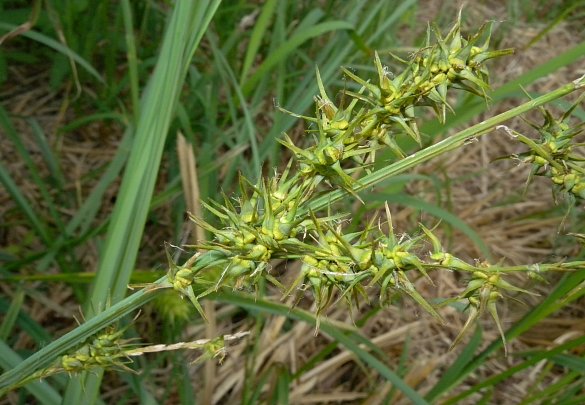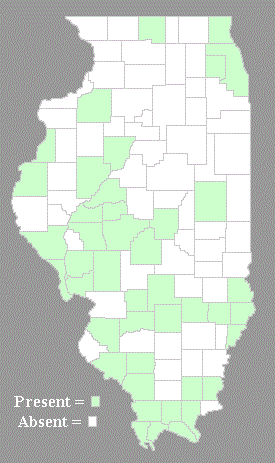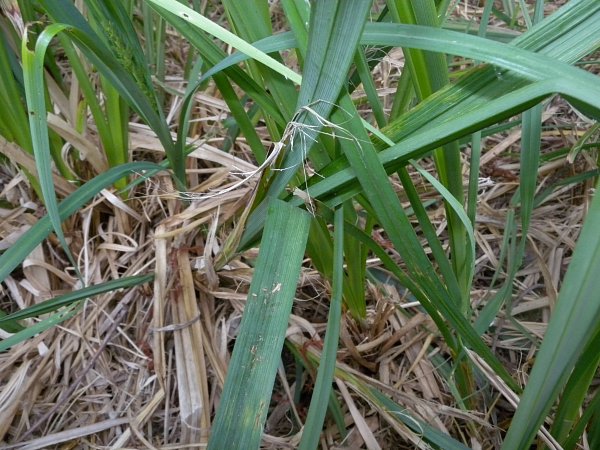
The culm terminates in a raceme of spikelets about 4-8" long and 1½-3" across. The lateral spikelets (branches) of the raceme are ascending and up to 2" long. Perigynia and their scales are distributed densely along these spikelets, facing in all directions. The long-tapering beaks of the perigynia provide the spikelets (branches) of the raceme with an especially spiky appearance. Some spikelets have a few staminate (male) florets and scales at their tips, otherwise they consist of the perigynia of female florets and scales. Individual perigynia are 5-8 mm. long and 1.5-2.0 mm. across; they are lanceoloid in shape with elongated narrow beaks and plano-convex. The perigynia are widest at their bottoms, where they are conspicuously swollen and cordoid. The perigynia also have short pedicels (about 1 mm. in length) at their bases. The swollen bases of immature perigynia are nearly white, while elsewhere they are grayish green. Mature perigynia become yellowish brown to brown. The outer sides of the perigynia have several longitudinal veins that are conspicuous. Their long slender beaks are 2-4 times as long as their main bodies. These beaks can be straight or slightly curved; they
 have 2 slender teeth at their tips. Two stigmata are exerted from the
tip of each beak. The pistillate (female) scales are ovate in shape and
about one-half the length of the peryginia (3 mm.); they are
green-veined in the middle and membranous along their margins. The
blooming period occurs from late spring to mid-summer, lasting about
1-2 weeks. The florets are cross-pollinated by the wind. About 1 month
later, the mature perigynia disarticulate from the raceme; they can be
distributed by water. The achenes are about 2.5 mm. in length, 1.5 mm.
across, ovoid in shape, and somewhat compressed. Sometimes the hardened
style can persist at the apex of an achene. The root system is
fibrous and rhizomatous. Colonies of plants often develop from the
rhizomes. Light brown remnants of older leaf blades and sheaths often
persist around the bases of such plants.
have 2 slender teeth at their tips. Two stigmata are exerted from the
tip of each beak. The pistillate (female) scales are ovate in shape and
about one-half the length of the peryginia (3 mm.); they are
green-veined in the middle and membranous along their margins. The
blooming period occurs from late spring to mid-summer, lasting about
1-2 weeks. The florets are cross-pollinated by the wind. About 1 month
later, the mature perigynia disarticulate from the raceme; they can be
distributed by water. The achenes are about 2.5 mm. in length, 1.5 mm.
across, ovoid in shape, and somewhat compressed. Sometimes the hardened
style can persist at the apex of an achene. The root system is
fibrous and rhizomatous. Colonies of plants often develop from the
rhizomes. Light brown remnants of older leaf blades and sheaths often
persist around the bases of such plants.Cultivation: The preference is full sun to light shade, wet conditions, and soil containing muck, loam, clay-loam, or silty loam. This sedge can tolerate flooded conditions if they are temporary.
Range & Habitat: The native Raven's Foot Sedge is occasional in the southern half of Illinois, while in the rest of the state it is uncommon. Habitats include wet prairies, swales and sloughs, open floodplain areas along major rivers, floodplain woodlands, edges of vernal pools in woodlands, swamps, low areas along lakes, and ditches. Raven's Foot Sedge is often found in habitats that are seasonally flooded. It is one of the more conservative wetland sedges.
Faunal Associations: Insects that feed on Raven's Foot Sedge and other sedges (Carex spp.) include Sphenophorus costicollis (Sedge Billbug), aquatic leaf beetles (mostly Plateumaris spp.), seed bugs (Cymus angustatus & Oedancala dorsalis), plant bugs (Mimoceps insignis & Teratocoris discolor), aphids (Rhopalosiphum spp., Thripsaphis spp., & others), several leafhoppers (mostly Cosmotettix spp.), the caterpillars of several skippers, the caterpillars of the butterflies Satyrodes appalachia (Appalachian Brown) and Satyrodes eurydice (Eyed Brown), the caterpillars of Hypocoenia inquinata (Tufted Sedge Moth) and other moths, and sedge grasshoppers (Stethophyma spp.). For a list of these species, see the Insect Table. Among vertebrate animals, many ducks, rails, and other wetland birds feed on the seeds of sedges (see Bird Table). White-Tailed Deer feed sparingly on the foliage, while the Muskrat feeds on the culms, roots, and sprouts to a minor extent. Large colonial sedges, like Raven's Foot Sedge, provide nesting habitat and cover for many kinds of wildlife.

Photographic Location: A low area along a lake in southern Illinois.
Comments: Raven's Foot Sedge (Carex crus-corvi) is one of the more unusual sedges (Carex spp.) because of its oddly shaped perigynia. It is a large wetland sedge that tends to stand out from other sedges because of its grayish or bluish green foliage and spiky inflorescence. Two similar sedges in Illinois are Carex stipata (Prickly Sedge) and Carex laevivaginata (Smooth-Sheaf Sedge). The perigynia of Prickly Sedge are smaller in size (4-5 mm. long) and their bases are less swollen than those of Raven's Foot Sedge. Smooth-Sheaf Sedge has perigynia that are similar in size to those of Raven's Foot Sedge, but it has more narrow leaves (3-6 mm.) than the latter. In addition, the foliage of both Prickly Sedge and Smooth-Sheath Sedge is typically light to medium green, rather than grayish or bluish green. Another common name of Carex crus-corvi is Crowfoot Sedge.